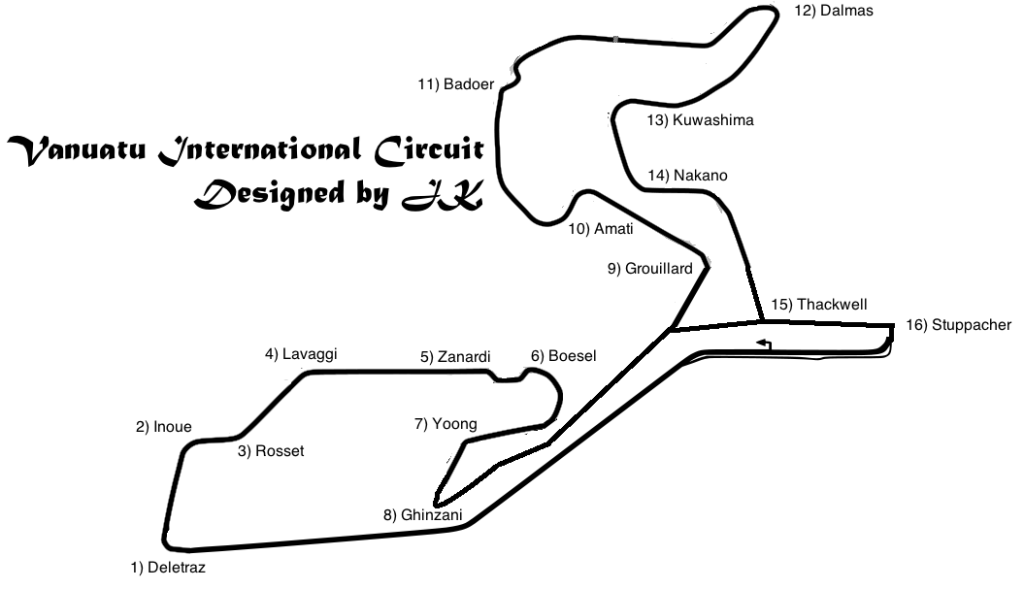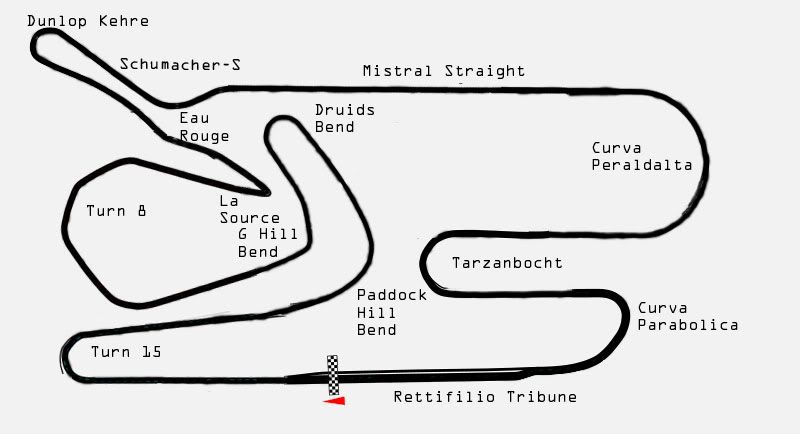Dear Captain Hammer: I would like to revive this thread by answering to some of your criticisms on criticisms. Whenever I have the time, I will upload my many track designs, and see if I can beat Tilke at his own game.
First of all, I've always been a major critic of Tilke's designs and re-designs of great racing tracks. But a few days ago, arguing this subject with my brother, I admitted that FIA's safety standards and protocols set hard boundaries on track design. Aintree, the Nordschleife Nürburgring or the old overlapping Monza track will never be concieved again under these rules. Sadly, no matter who the designer is, to meet FIA approval, tracks cannot differ much from Tilke's designs.
I think that all the deaths in F1 in the past, specially all the ones in the "modern" era (1970 -) have had much impact on F1 fans and, particularly, racing drivers. Villeneuve's death and, later, Senna's have set before and afters. 1994 was an inflexion point in "modern" F1 history. Saftey became primary concern for the FIA. F1 today is a byword for safety in automotive sport. I doubt any other sport is as safe as F1 has been over the last 10 years. The worst crash I've seen in the last decade was Kubica's in Canada, and he escaped a 12 g impact with only a twisted ankle and consciousness loss for a few minutes.
Do not misunderstand me. I'm not second guessing here. I'm trying to point out differences between the past and the present. Today's monocoque crash tests and construction techniques mean Villeneuve and Rindt would have escaped injured but alive (again, look at Kubica's crash in 2007). Medical assistance, staff and facilties mean that Ronnie Peterson would have probably survived his fractured legs (Schumacher Silverstone 1999). Armcos and tyre walls mean Helmuth Koinigg would have bounced, not die stuck underneath the wall (Hülkenberg Monaco 2010). Fireproof clothing would have protected Schlesser in 1968, and modern fuel tanks would have prevented Stewart from being soaked in fuel. We all know this stuff, but don't consider me Captain Obvious yet. The list could grow a lot larger. But the point is not to list every single advance in safety. No, my point is that today we have overcome most of the technical stuff that meant risk to drivers. And I doubt we can increase safety in the same proportion as the 1990-2000 period has seen.
Therefore, having overcome all the things that killed brave men in the past, I see no point for many standards of today. Why is there still a Bus Stop in Spa? You might think arriving La Source at 330 kph (205 mph) is very dangerous, but remember today's Bus Stop (2012) is a double hairpin (it's not even a normal chicane anymore), and cars arrive the first hairpin after the long Blanchimont run at nearly 320 kph (200 mph). Grandstand spectators are protected from possible debris with modern catch fencing (correct me if I'm wrong) 5 or 6 meters tall. So there is no true reason for having the Bus Stop today. 1988 yes, 2012 not really. Do not forget Monza's 370 kph (235 mph) record right before the first chicane, where everyone comes to a near halt. So don't tell me the fairy-tale of danger at the entrance of La Source. Grosjean being at the wheel is a valid argument, though. xD
Senna was killed by a combination of basilar skull fracture (today prevented with HANS) and brain damage from a helmet puncture (prevented by Carbon Fibre - Kevlar helmets - Massa 2009) from a flying wheel + suspension part (today prevented by reinforced CF+K wheel links that prevent them from flying around in case of accident). I do not know of any other cause of death (not discussing track departure here) of Ayrton Senna. Hard accidents occured before in Tamburello and none ended up in death. Therefore, today, the Traguardo-Tamburello complex is pointless. Not the Villeneuve one, since the entrance speed at La Tosa would be insane and there is no room for runoff areas there.
I found this image a few days ago and it made me laugh really hard because it reflects reality quite well.

Here's what I see wrong with his tracks:
- Extreme track width: The racing line has little to nothing to do with the actual track design. Seriously, is this a joke?
http://img193.imageshack.us/img193/3739/0001fripic1.jpg- Overly complicated corner complexes: Cars have to form a processional line without any chance of overtaking on the inside or outside, since, despite enromous track width, there is no outside or inside. First lap procession usually ends up in penalties since overtaking attempts end up outside the track limits.
Examples:
+ New section (Turns 4-13) - Bahrain 2010
+ Mercedes Arena - Nürburgring
+ New infield section - Silverstone
+ Turns 10-13 - Singapore
+ Turns 17-22 - Singapore
+ The whole final sector - Valencia
+ Turns 7-18 - Korea
+ Turns 1-2 double-hairpin - Malaysia
+ Turns 1-4 Curly corner - Shanghai
+ Turns 11-13 Curly corner 2 - Shanghai
+ Turns 2-10 - Austin
- "Encouragement to overtake" features, that usually are long straights that end up in hairpins. That added up with the ban on blocking moves and the availability of KERS and DRS make it certain the car behind
will overtake. But overtaking is not a synonim of entertainment. Dijon had no overtaking features, it was just a sucession of fast sweeping bends, and the final laps of the 1979 French GP were, I think we can all agree, the best 3 consecutive laps in F1 ever. Even despite China has the most amount of overtakes in the calendar, according to a multi-axis chart I saw.
- Huge run-offs: I understand asphalt run-offs are the popular choice now, since they allow drivers to further control their cars outside the track, rejoin the race and slow the car before hitting the wall. Yes, it saved many from early retirement. I'm 100% on safety, but preventing cars from stalling if they depart the track, that is in my opinion, moronic and childish. That is not safety. Do you want to undo a mistake? Play GRID, play Codemasters' F1. I'm OK with them, but not 100 meters-wide. Look what he did to Pouhon in Spa. Not only was it magnificent to behold, but seriously challenging if you steered too late or too fast. Now cars run out of space and keep going like nothing happened, like Kimi and Hamilton did in 2007. What the hell?! What's the track design for, then? Just put 20 walls and let cars take the trajectory they want.
- Hockenheimring redesign: This is by far the most insulting work of Tilke. You might think the forest section wasn't challenging, and you have the right to think so. I, myself, think NASCAR and Indy are moronic because they just tackle 2-4 bends and never brake (not talking about road courses, just ovals here). But still, you must have serious balls to drive close to a wall at 300-380 kph (185-240 mph). And the forest section of the Hockenheimring was just as "dull" as the whole Monza circuit. Do you think Monza is boring/crap? Even if you believe so, you'd think twice before making such remark. The fun of the Hockenheimring was to setup the car with such balance that made it possible to tackle the slow stadium section while still being the fastest through the forest section. And the track wasn't even half the width of Daytona, Indianapolis or even Talladega. Cars rose to 340-350 kph (220 mph) for very, very long runs, very close to each other, but not in an infinite oval fashion, as in the US, but headed towards a full halt for the chicanes. Accidents were heavy, racing was incredible and concentration needed was tip-top. And the most annoying thing was that the old track was demolished to "plant" some stupid grass and the whole center of the new track was cut down to the ground and they concreted all over. I understand you found it boring, but the new layout is crap and you must understand how insulting it is to destroy the old track and not leave it for revival races or private use. After all, the old oval in Monza or the old Österreichring can be, in greater or lesser way, still used.
Now I'll reply to you on things that would improve the Tilkedromes, and as you said, I have found no access to track regulations speaking about bankings, entry speeds, and so on to justify my statements as possible today. But as I said before too, I think safety standards are way beyond track regulations.
Revert the last two changes in Catalunya, use the 2001 layout. Those final bends in use today make me suicidal.

The Singapore track is far too complex and stressing. A bit more air is needed, longer straights, a few less corners and a bit roundier. A bit less heavy braking. Here's my proposal on Singapore. Note the reprofile on the first corners, less eager to throw cars out of the track. The faster ex turn 5, the longer straight, the lack of ex turns 7, 8 and 9, and the lack of the pointless turn 10 chicane. Turns 20-22 have been removed in favor of a tunnel under the highway and a bus stop before the final bend because otherwise there's not enough run-off space for a high entry speed. The final 2 apexes have been rounded up. I do not like angled corners.

The Malaysian track is not as compex as Singapore, but it isn't easy on the drivers and the cars. The first corner is stupid and far too slow for modern cars. I understand the super-tight hairpin in Monaco but not in a giant brand new circuit built from the ground up. I've reprofiled the first section and the two angled corners behind the final bend, "KLIA Corner", to make them slower-in faster-out than before. I also changed the second to last corner because it's way too hard to tackle and there's no overtaking place at all.

I had no time to further redesign Tilke's tracks. I only like his A1 track in Austria, but I still think the older was better.
To tackle on your challenge, I give you a further few redesigns on other circuits. You give me your oppinion. I will be uploading more designs in the next few days.
Australia: changed the Waite chicane to a fast sweeping left-right bend. There is enough space for run-off to allow cars to tackle flat out this corner. The rest is original design.

Argentina: used a mixture of the old 15 circuit and the latter 9 circuit for maximum challenge. Revived the old Ascari corner now inexistant except for the first 20 meters. There is enough room for run-off area and being wide enough, can provide show as good as Eau Rouge.

Australia: extended the circuit to a greater length than the old 1985-1993 layout. Added a slight kink to change lane on the boulevard after turn 6, but it won't affect speed. There is enough space to make it very wide to prevent accidents and corner cutting. The long fast back run will be extremely exciting with the fast bend.

More to come soon. I hope I'm up to your challenge, despite arriving 3 years late.
Dario Fernandez























